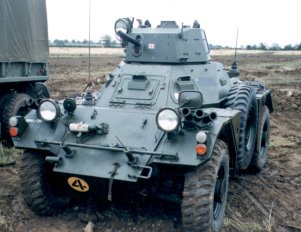Daimler Ferret Scout Car

Manufacturer: Daimler Ltd., Coventry, England.
Developed shortly after the Second World War, the first Ferret prototypes ran in 1949; production commenced three years later. A total of over 4400 of these rear-engined 4x4 scout cars were built before production ceased in 1971.
A Ferret carries two people: the driver, at centre-front; and the commander, in the turret in the middle of the vehicle. (The turret is the same item that’s used on the much larger Saracen armoured personnel carrier.) Motive power comes from a six-cylinder relative of the Saracen’s Rolls-Royce straight-eight petrol unit, propelling the Ferret to a maximum of nearly 60mph. The Ferret is still in service in many territories.
Development of the Mk II and Mk III versions led to a new kind of Ferret, with a flotation screen and larger wheels. Christened by one enthusiast (the late John Jarvis-Walters) ‘Arnold Schwartzenferret’, the Mk IV was not an unqualified success as a swimmer (or as anything else), but led to the development of the Fox light armoured car which saw several years’ production.
Technical specifications
Engine: Rolls-Royce B60 Mk 6A 6-cylinder in-line liquid-cooled
petrol producing 129hp at 3750rpm
Maximum speed: 93km/h
Fuel capacity & range: 96l, 300km
Armament: 7.62mm MG, 2x3 smoke grenade dischargers
Combat weight: 4.4t
Length: 3.835m
Width: 1.905m
Height: 1.879m
Armour: max. 16mm
Crew: Two